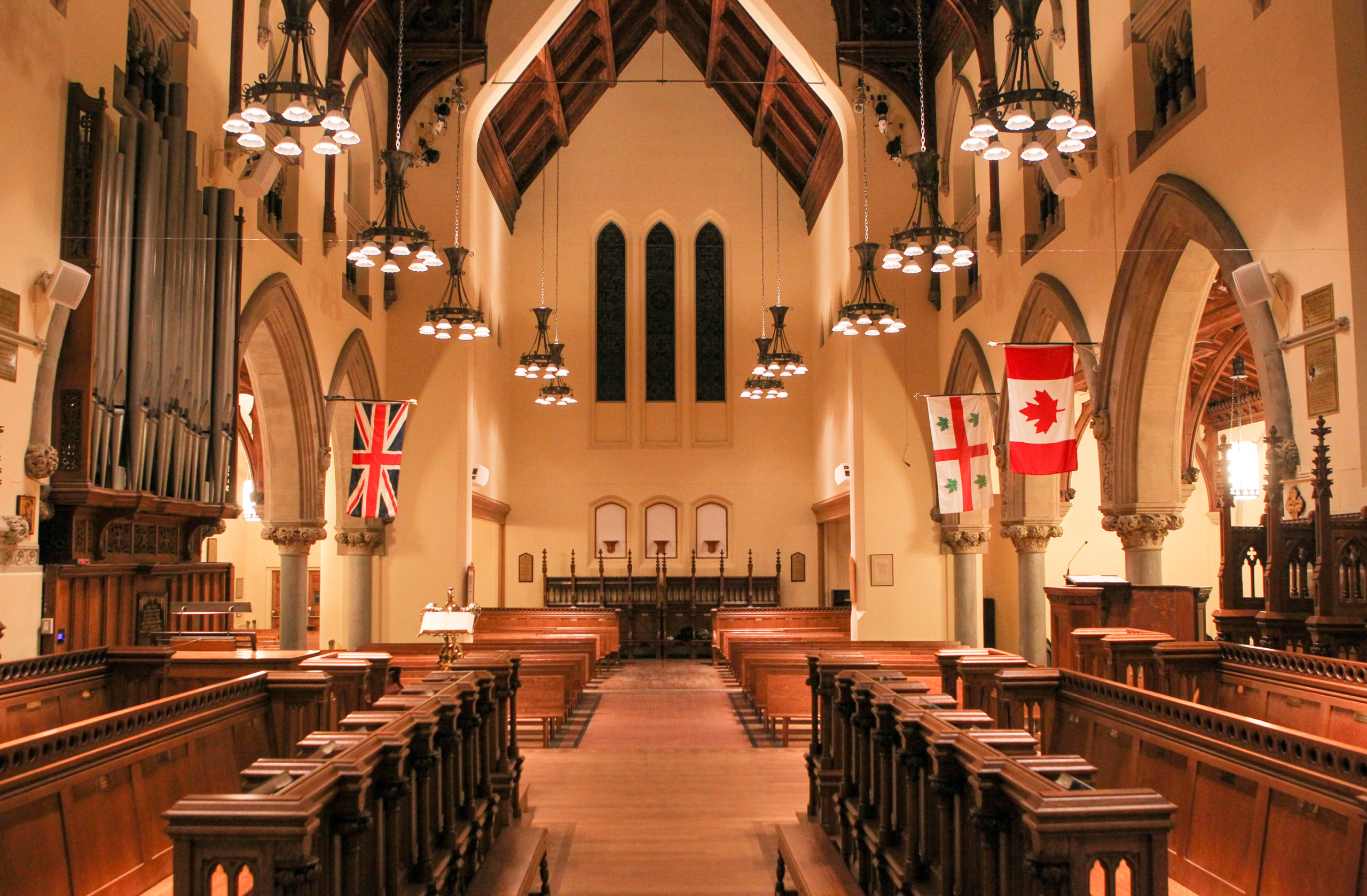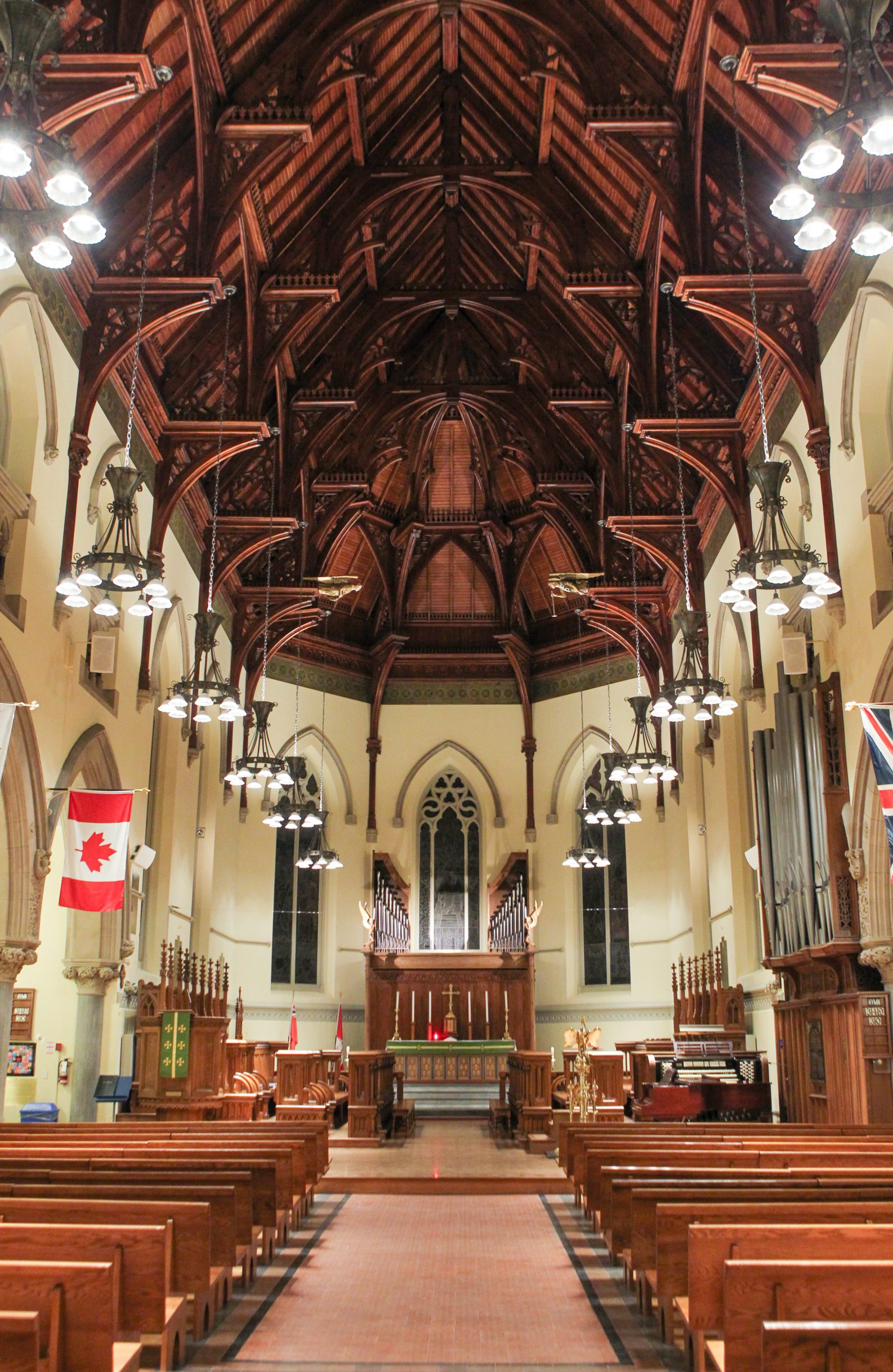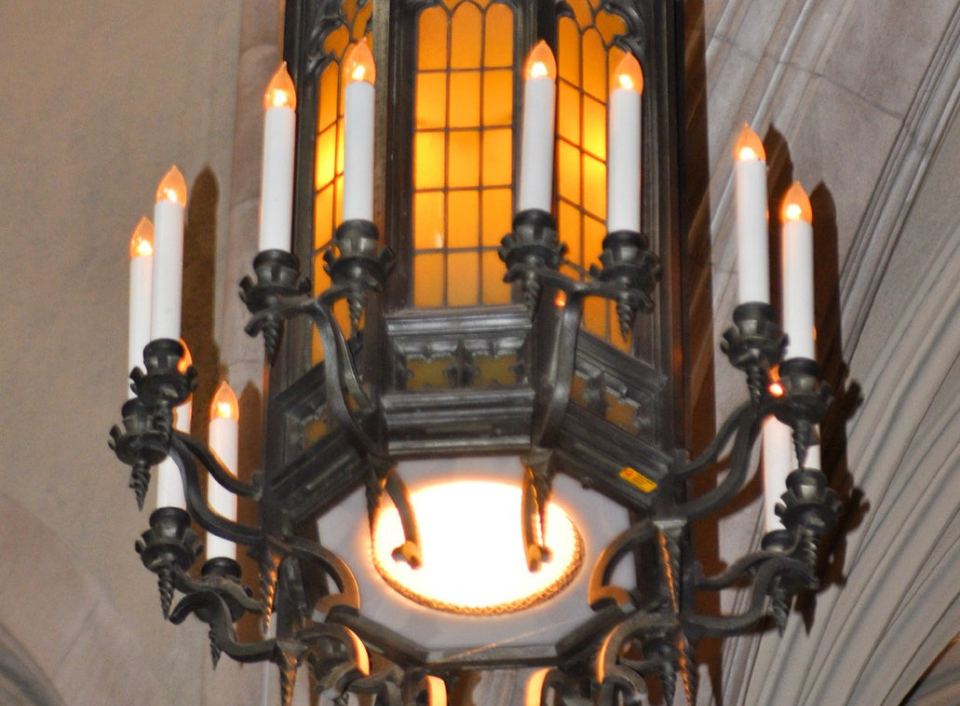All photos courtesy of Deborah Gottesman, www.gottesman.ca; Photography by Cody Stone Cooper
“Worship is an intensely personal endeavor that may or may not involve a community of participants. Lighting should acknowledge and enhance this deeply personal act…”
IES Handbook, 10th Edition, p. 1247

This article is an overview of the design issues and challenges of lighting in houses of worship. With a real-life heritage project to illustrate.
Aesthetics
Luminaire aesthetics are critical, whether the church is a traditional or modern design. Every element of the architecture, including, or even especially, the luminaires, must work in a cohesive fashion to strengthen the overall impression of space and light.
Luminaire material finishes must be coordinated. Glare control, always an issue in lighting design, is a critical element in houses of worship. Any glare in the field of vision for participants must be avoided.
Luminaires in houses of worship are likely to incorporate translucent elements. The color and diffusion of these materials will determine the success of the design as well as contributing to glare control.
Performance
The designer must determine the appropriate vertical and horizontal illuminance, especially considering an aging population. An adult over sixty years of age requires almost three times as much light as a person in their twenties.
Traditional church lighting will represent, on average, over 25% of the operating cost in a house of worship. The rapid evolution of white light LED sources has enabled designers to greatly reduce the electrical load from lighting and therefore the operating cost. This can be critical for church organizations with limited resources for operations and maintenance.
In most cases, the designer will specify light source color rendering and color temperature which approximate the appearance of incandescent sources. However, some consideration must be given to daylight integration. Large windows are a standard feature of houses of worship, and this means significant daylight in the space. Unless modified by stained glass, the predominant color temperatures will be quite high, typically 4,000K or more. LED sources give us the luxury of adjustable color temperature, and that may be appropriate in some projects.
High ceilings are common features in houses of worship. Most spaces will require some uplight, and this is especially true of exposed wood ceilings. Another advantage of uplighting is that this technique enhances the uniformity of illuminance throughout the space.
Stained glass windows are glorious in the daytime, but at night can become very dark. Carefully designed exterior lighting, which is usually present for security and safety of church members, can also contribute some backlight to the stained glass, making evenings services more dramatic.

Luminaires
There are a number of situations where the use of a custom designed luminaire might be preferable.
Lighting for houses of worship is very specialized, and there are few manufacturers who offer appropriate luminaires. If there is no commercially available catalog fixture available, a custom luminaire may be the only recourse.
In the case where the original luminaires are to be retained, in most instances, they will need to be renovated to meet current electrical code requirements, to accommodate new technology light sources, or to provide uplighting.
Other advantages of new custom luminaires are greatly enhanced performance, and reduced maintenance.
If the team decides that custom made luminaires will give the desired results, the design process will need to change. The designer will need to determine the performance of such a luminaire. This is complicated by the fact that the luminaire doesn’t exist, so luminaire photometric files are not available. Designers can use software to estimate the performance of custom luminaires. Another common approach is to build a full-size sample or mock-up. This is often a better approach, as it allows the client to have a real impression of the appearance of the new luminaire, and the designer will have higher confidence of the performance.
Controls
Most of the celebrants and volunteers in houses of worship are not electrical engineers, so ease of use of the lighting controls is essential.
Wireless lighting controls are readily available, even through big box stores, and these can enable multiple locations. For example:
1. A light switch near the entrance for basic general illuminance for a volunteer or cleaner.
2. A lighting control for the pulpit, so that the celebrant can change illuminance levels for special occasions, such as candlelight ceremonies.
3. A lighting control for the organ loft so that the organist or choir director can change lighting levels as required.
These controls can also be linked to smart devices, so that the ‘switches’ are portable.
Another element of houses of worship, and the element which is closest to the hearts of many worshippers, is the special event. This can be part of a religious tradition, such as Christmas, or a very personal event such as a baptism, a wedding, or a memorial service. Lighting design and especially controls must accommodate these life events.
Life safety is essential, and appropriate lighting controls can be specified to ensure sufficient illumination in the event of an emergency.
Related Spaces
Most houses of worship also incorporate one or more meeting spaces for community events. These spaces have a wide range of uses, but the lighting is often an afterthought. A lighting designer can specify luminaires and controls to enhance the flexibility of the space, and improve the experience for participants.
Almost every house of worship in North America has an adjacent parking lot, and the lighting can be a key element in defining the attractiveness, the safety, and the utility of the building in the evening. Exterior lighting can also enhance the building’s physical presence at night.
The Process
A lighting designer will start with a User Needs Analysis, which thoroughly catalogs all of the different lighting tasks throughout the space. This will assist in generating a design which will meet the needs of the users, their expectations, functions and tasks. Without this step, it is virtually impossible to ensure successful results.
The Challenge – A Case Study
The Chapel at Royal St. George’s College, which was built in 1890, is in The Annex area of Toronto, Canada. As is the case with most re-lighting houses of worship projects, the requirements were more light, more control, less energy, and a low project cost. Add into the mix that this was a Heritage site, and the task could seem daunting. Deborah Gottesman of Gottesman Associates, an architectural lighting design practice in Toronto, was awarded the challenge of this Chapel. Deborah’s starting motto for any project is, “If you listen carefully to the narrative of the project, the lighting concept emerges from that.”
This was going to be put to the test from Parks Canada’s Standards and Guidelines for the Conservation of Historic Places in Canada. Standard 11 states:
(a) Conserve the heritage value and character defining elements when creating any new additions to an historic place or any related new construction. (b) Make the new work physically and visually compatible with, subordinate to, and distinguishable from the historic place.
The Chapel area had an existing light level of 40 lux (4 foot-candles) at the pews in the evenings. This is woefully low for reading text and had to be increased. The double hammer beam ceiling reaches a height of 21 metres (70 feet). Over a hundred years of smoke, soot, dust, and other light absorbing materials had settled onto the surface of the ceiling. As any graduate from the IES Lighting Fundamentals basic course will know, the reflectance of the ceiling is a key factor in delivering the required light to a task. Basic maintenance principles consider room surface dirt depreciation. Just think of what the RSSD light loss factor would be for over 100 years. The challenge and goal were to reveal the ceiling, not accent it to avoid it becoming a distraction.

This before image shows how dark the ceiling was, even with the sunshine streaming through the large stained glass windows. Also note the existing heritage chandelier luminaires which made up the entire ambient lighting, as well as the small front stage platform.
Part of the overall retrofitting goal was to build out the stage area for choral and theatrical live events. This was not happening at 40 lux. While Heritage Guidelines can be a challenge, they do allow for modifications to allow the space to continue to be beneficial. As Deborah so aptly explains, “If you have a heritage site and you can’t modify it in any way to make it useful for today, you’ve effectively lost its complete purpose.” In reference to retrofitting the existing luminaires, Deborah suggested “It was a matter of finding a respectful modification.”
The Solution – Retrofit, Customize, Repurpose and Conceal Additions

The first step, while simple, was certainly not easy, and that was to clean the 100 years of grunge from the hammer beam ceiling that peaks at 70 feet. A subcontractor specializing in such endeavours was called on and the result was remarkable.
A custom upper trumpet was added to each modified chandelier to house and conceal four uplights. Glass shades were added to the downlight portions of the chandeliers to diminish glare and 15-Watt PAR30 LEDs replaced the original incandescent sources. This gave a savings of 83% off the connected load.
Custom dimmable pendants which augmented the chandeliers in the main Nave and Apse areas were designed and installed in the Transepts. The existing glass pendants were respectfully removed for repurposing. Small accent tight beam luminaires, which were hidden in the window frames, were used to highlight the angels at the altar.
To allow for the goal of choral and theatrical performances at the expanded front stage, a new theatrical lighting and controls system was integrated with the luminaires strategically installed high on both sides of the arch.

At the maximum setting the illuminance in the pews is greater than 300 lux (30 fc) at 30” above the finished floor. Uplights and downlights are controlled separately, and the appropriate light levels can be tuned to meet all of the varied tasks required through lighting controls.

To summarize the project, the goals were met for functionality, flexibility, heritage requirements and budget. Although, as a Heritage project it was exempt from lighting power density, it outperformed the National Energy Code for Buildings and ASHRAE 90.1 by 40%. This project was awarded an Illuminating Engineering Society (IES) Illumination Award of Merit.
Deborah stated, “Every project has guidelines. It is not restricting, it is challenging.” It is the way she and her company approach all projects, it is a “Balancing act of making the space what it needs to be, while still respecting what it was.”
References: IES Lighting Handbook, 10th Edition, Chapter 37, IES, New York
IES RP-41-20 Recommended Practice for Lighting Theatres and Worship Spaces
IES RP-28-20 Recommended Practice for Lighting and the Visual Environment for Older Adults and the Visually Impaired



